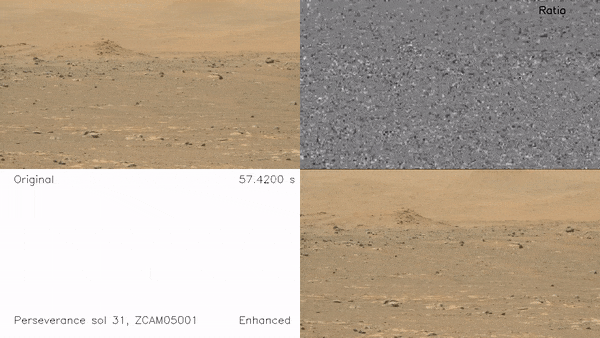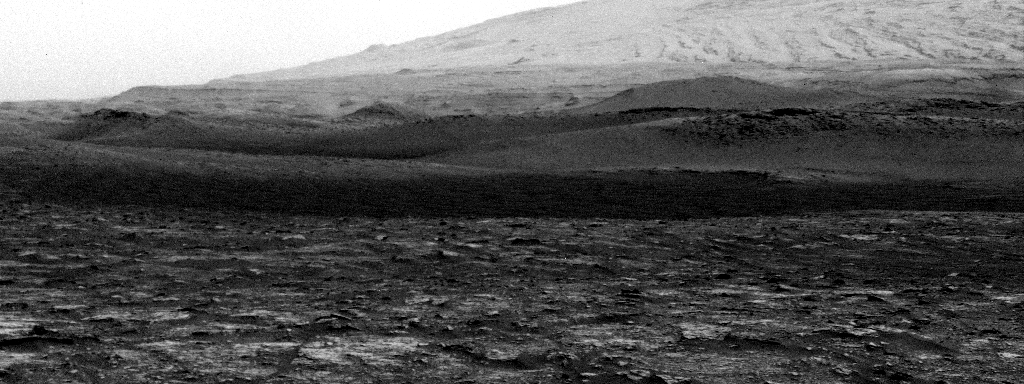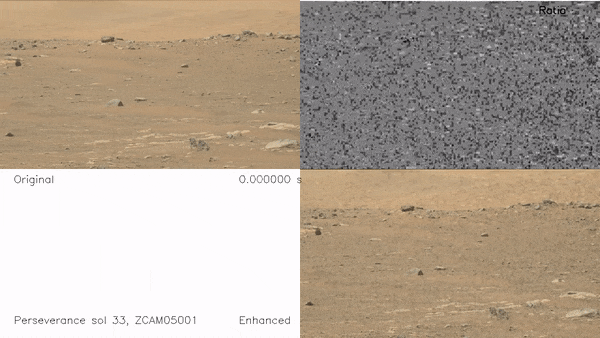
2021-05-26
Dust Devil Photobombers!
Contributed by Mark Lemmon
Dust devils photobombing NASA’s images of Mars are not new. Pathfinder, Spirit, Opportunity, Phoenix, and Curiosity have all seen the dust-filled whirlwinds moving near them on the surface. They were seen from space in the 1970s by the Viking Orbiters, and have been seen by other orbiters since then. Perseverance has been unique in how frequently the dust devils have been seen early in the mission, and in getting some special new observations with Mastcam-Z (more on those at the end).
Earth-bound dust devils are commonly (but not only) seen in desert environments. Air that is warmer than the environment rises. During a turbulent time of day, the winds can spin around a small low-pressure area—known as a vortex. When the winds encounter dust (or trash, or even snow) that can be lifted, the vortex becomes visible, and the dust is lifted high into the atmosphere’s boundary layer (the turbulent region near the surface). The vortex is typically powered by temperature differences between the surface and the top of the boundary layer. Tornadoes—also winds that spin around an area of low pressure, but with much greater force—are powered in a more complex fashion by large-scale circulations and the energy carried by water vapor. There are no tornadoes on Mars.
Perseverance joins Pathfinder, Phoenix, and Curiosity as missions that have measured the pressure changes as vortices drift across the landscape, as well as having seen dust devils. The Viking Landers and InSight (as of this writing) have no imaged dust devils despite having vortex detections, while Spirit and Opportunity did not have instrumentation to measure pressure or winds. On Perseverance, the Mars Environmental Dynamics Analyzer (MEDA) instrument measures pressure, temperature, and winds; the Navcam cameras and the Mastcam-Z cameras have both directly imaged dust devils.

Many dust devils are easily visible, such as in the example above from the Spirit rover. These dust devils occur in places with a ready supply of dust; for example, many small, dust-filled craters (aka, “hollows”) sprinkled the plains of Gusev crater around Spirit. Time-lapse imaging has been used to show dust devils moving across the surface, tracing background winds, and showing the changing shape and dust content of the vortices (see Spirit ‘movie’ below).

Other dust devils can be harder to spot—Mars is dusty, and seeing just a little more dust in a dusty atmosphere and above a dusty surface can be difficult. In these cases, time-lapse imaging allows dust devils to be found. By examining the ratio of each image to an average of all images, static features can be removed and moving features can be isolated. These motion-filtered image can be multiplied back into the original to enhance the moving dust devil. This technique was used commonly to see the least dusty devils at Gusev and has been necessary for most dust devils seen by Curiosity at Gale crater, where there are plenty of vortices but less mobile dust than at Gusev. The example below from Curiosity sol 2847 shows a dust devil that was visible in raw images but has been enhanced to make its features easier to identify—the process also leaves a tell-tale increase in noise, or spurious variability in pixels around the image.

Perseverance’s first month or so on Mars has been a time of easy spotting of dust devils. Indeed, even just before landing, video taken during the descent brought a surprise: a student not affiliated with the rover spotted a dust devil near the eventual landing site and announced it on Twitter:
A little while ago I spotted this Dust Devil in the LCAM images that @NASAPersevere captured during the landing phase on Sol 0. It therefore is the first ever Dust Devil seen by the mission – before it even touched down.
— Simeon Schmauß (@stim3on); April 6, 2021.
The Perseverance rover’s Navcams also detected a dust devil in the background as the robotic arm was being tested on sol 17 (8 March 2021). This set of images was enhanced to highlight moving features, showing the dust devil (but also producing artifacts around the arm itself), as shared on the rover’s Twitter feed:
Spotted a dust devil. You can see it in the distance behind my robotic arm in this enhanced/processed view. The dust devil is moving right to left and creating whirlwinds of dust in its path.
— NASA’s Perseverance Mars Rover (@NASAPersevere); March 16, 2021
At least 5 dust devils have showed up in drive-related images, for example in this crop (below) from a blink-GIF of sol 33 pre- and post-drive imaging. In these cases, dust devils are visible in simple contrast stretches without other processing. (Hint for dust devil spotters: check out sols 15, 23, 33, and 34.)

Dust devil surveys have shown even more dust devils. In these surveys, five directions are imaged, each with a 90-degree wide field of view and going all the way around the rover. For each direction, three images are taken, which allows motion-filtering. Dust devil hunters may want to check out the images from these surveys, available from the NASA/JPL Perseverance raw images web site.
So, where does Mastcam-Z come into this story? There was a process defined before the rover landed to investigate the behavior of dust devils. First, survey: identify when and where dust devils could be seen. Second, take Navcam time-lapse video over wide angles to better characterize where to see dust devils and how they move and evolve—much like the Spirit and Curiosity time-lapse sets. Third, when a place with reliable dust devils has been identified, use Mastcam-Z video to get higher-speed imaging that can be used to study the dust devil’s rotation rate and the rate at which clumps of dust are transported upward. The rotation rate gives wind speeds, when coupled with a distance estimate. The upward transport of dust is a key parameter in knowing how much dust is being put into the atmosphere by dust devils—we need to know how common they are, how big they are, how much dust they pick up, and how fast that dust moves upward.
Mars had other plans. Dust devils showed up before dust devils surveys were used. The Navcam dust devil movies have not been tried yet. We certainly were not ready to try to target a dust devil video. However, on sols 31 and 33 Mastcam-Z was used in video mode (at about 7 frames per second) to test the process of taking a long video and getting the data down. This was done, not for dust devils, but for preparations for eventual video of the Ingenuity helicopter in flight (even before Ingenuity deployed to the surface).

And guess what showed up in the test? A dust devil can be seen moving through the field of view about 60 seconds into the about 7-minute video on sol 31 (above). It was dusty enough to be spotted by a team member in the raw images, but not dusty enough to see clear detail. This is where the motion filtering helps. The average scene was constructed from 200 of the 1408 images in the video test, using ones before and after the dust devil appeared. Each image was ratioed with the average. Because the video was made with lossy-compressed data, this process showed frames full of compression artifacts. To mitigate this, motion-filtering was done again after down-scaling the frame size by 4x. In addition, the less-noisy green channel was used, and the noisy red and blue channels were temporarily set aside. In the video below, the raw scene is shown downscaled 2x in the upper left; the motion-filtered frame is shown after being upscaled 2x to match; and the enhanced frame is shown in the lower right.
A second video test was less flashy but not fruitless. In addition to being a successful test for helicopter movie preparations, it also caught a second dust devil. This one was much fainter, and only seen with the special processing. In fact, the video below uses an additional technique to reduce noise by averaging in time. If you look closely in the upper part of the image, a third of the way from left to right, there is a slow moving and faint dust devil throughout the video.

This is a promising start to the Jezero crater dust devil campaign! Shortly after these test videos were acquired, a series of dramatic “real” movies were taken with a definite target, Ingenuity. But intentional dust devil surveying, time-lapse movie making, and video-rate movie making is likely to capture a great deal of new behavior and with even faster frame rates in the video to study dust transport within the vortex. And, don’t panic! As common as the dust devils are in the images, they occur across a large area. No one location is at high risk of a direct hit at any given time, so the chances of any interference with Ingenuity flights remains small.